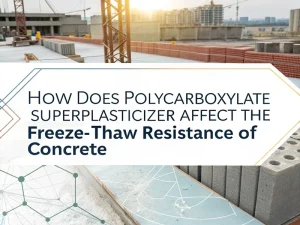
The Influence Of Polycarboxylate Superplasticizer On The Setting Time Of Concrete
Blog The influence of pol
Blog
Concrete, as the cornerstone of contemporary architecture, is highly sensitive to temperature fluctuations. In cold weather, this environment poses a serious threat to the performance of concrete. When concrete is poured at low temperatures, the hydration reaction of cement will significantly slow down, or even completely stop, leading to delayed setting, insufficient early strength, and greater susceptibility to freeze-thaw damage (water in the pores freezes and expands, causing cracking).
For construction projects that cannot be halted during winter, cold-weather concrete additives can effectively address the challenges of low-temperature concrete, ensuring its normal setting, rapid development of strength, and resistance to freezing damage.
However, the consequences of choosing or using these external additives incorrectly may be worse than not using them at all. This guide will delve into everything you need to know to ensure that your concrete engineering not only continues in cold weather but also achieves excellent quality.
The three core threats of cold weather to concrete:
Cement hardening requires the heat released by the hydration reaction as support. When the temperature is below 10 ℃, the hydration rate decreases by more than 50%. When the temperature drops below 0 ℃, the reaction almost completely stops. This means that the concrete may take several days (rather than the normal hours) to set, severely delaying the removal of formwork and subsequent construction progress.
If the hydration reaction is insufficient, the concrete cannot develop sufficient early strength, making it difficult to withstand construction loads (such as compaction by construction vehicles) and unable to resist frost damage. When the compressive strength of concrete does not reach 3.5 MPa (500 psi, which is the “frost resistance critical strength”), permanent damage will occur once it encounters freezing temperatures.
Even if the concrete has set, the moisture in its internal pores can still freeze at low temperatures during the night. When water freezes, its volume expands by approximately 9%, and the resulting internal stress can cause concrete to crack. After repeated freeze-thaw cycles, cracks will continue to expand, ultimately damaging the durability of concrete.
Definition: An early strength agent is the most commonly used admixture in cold weather, a type of admixture used to shorten the setting time of concrete and improve its early strength. It is mainly used in low-temperature construction or projects with early strength requirements. Its main varieties include chlorides, sulfates, nitrates, carbonates, and formates, with a dosage of 1% to 2% of the cement dosage. When used in combination with triethanolamine, the early strength effect is more significant.
This dosage form works by accelerating cement hydration and must meet the physical properties of powder and dryness to be suitable for dry powder mortar applications. Calcium formate is a typical representative, with a molecular formula of C₂H₂CaO₄, appearing as a white or slightly yellow, flowable powder that promotes both setting and anti-freezing auxiliary functions. It is widely used in ceramic tile adhesives, cement-based plastering mortar, repair mortar and other products.
Definition: Antifreeze lowers the freezing point of pore water inside concrete, preventing water from freezing and allowing hydration reactions to proceed normally in environments below 0 ℃, similar to the effect of car antifreeze. But please note that they are not car antifreeze! Their main function is not simply to prevent water from freezing. True antifreeze is a powerful composite additive that can significantly lower the freezing point of water and accelerate hydration reactions.
Main types and working principles:
Ethylene glycol derivatives: These organic compounds can bind with water molecules and lower the freezing point to below -10 ℃. Adding 5% ethylene glycol derivatives based on the weight of the mixing water can keep the pore water liquid at -5 ℃, ensuring continuous hydration.
Sodium nitrite (NaNO ₂): a dual effect additive that combines antifreeze and rust prevention functions. On the one hand, it lowers the freezing point to -8 ℃, and on the other hand, it forms a protective film on the surface of the steel bars to prevent rusting.
Urea: an economical and non-toxic choice, suitable for civilian projects. Adding 10% urea by weight of mixing water can lower the freezing point to -6 ℃, commonly used in cost-sensitive scenarios such as residential driveways.
Applicable scenarios: extremely cold environments (-10℃ -0℃), projects where concrete may experience freezing before reaching critical strength (such as outdoor pavement poured in winter).
Definition: Although air entraining agents are not exclusive to cold weather, they are a “necessity” for concrete that needs to withstand freeze-thaw cycles at low temperatures. It forms tiny and stable bubbles (with a diameter of 0.01-1mm) inside the concrete, serving as a “pressure relief valve” when water freezes and expands, preventing concrete cracking.
Working principle: The air entraining agent captures air during the mixing process, forming a uniformly distributed network of bubbles. These bubbles do not affect the strength of the concrete but can absorb the expansion pressure generated by the freezing of moisture. If no air-entraining agent is added, the internal stress generated by frozen moisture will directly cause concrete cracking. After addition, pressure can be dissipated through the formation of bubbles.
Applicable scenarios: Concrete exposed to moisture and freeze-thaw cycles (such as roads, bridges, sidewalks, exterior walls).
Definition: Low temperature can make concrete sticky and difficult to construct. Water-reducing agents disperse cement particles, reduce the amount of mixing water, and lower the water-cement ratio (w/c), while ensuring workability, thereby improving the strength and durability of concrete.
Applicable types for cold weather:
Polycarboxylate based high-efficiency water reducer (PCE): The most effective water reducer can reduce mixing water by 20% -40%, reducing the water-cement ratio from 0.55 to 0.38 while maintaining high fluidity. This can not only accelerate strength formation (reduced moisture means fewer pores), but also reduce the risk of frost damage (dense structure reduces pore water content).
Naphthalene-based water reducing agent: a more cost-effective choice with a water reduction rate of 10% -20%, suitable for projects with lower performance requirements (such as municipal pipeline trench pouring), suitable for temperatures ranging from 5 ℃ to 10 ℃.
Applicable scenarios: Projects with dense steel reinforcement (requiring high fluidity concrete), rapid formation of strength, and inability to add additional water.
Definition: A retarder may seem contradictory to the needs of cold weather, but it is indispensable in specific scenarios – for example, concrete is mixed in a warm mixing plant (20°C) but transported to a cold construction site (5°C). If a retarder is not added, the concrete may solidify prematurely during transportation, forming “waste slurry” (hardened concrete that cannot be used in construction).
Working principle: retarders (such as lignosulfonates and sodium gluconate) slightly delay early hydration, extend the workability window of concrete (1-2 hours), ensure normal pouring after transportation to the site, and do not affect final setting and strength development. The dosage is usually 0.1% to 0.3% of the cement weight.
Applicable scenarios: projects with mild and low temperatures (5 ℃ -15 ℃), long-distance transportation of concrete (commercial concrete), and large temperature differences between mixing plants and construction sites.
Even if suitable additives are selected, improper use can still lead to ineffective effects. Following the guidelines can maximize the effectiveness of additives and avoid cost waste:
The impact of cold weather on concrete varies depending on the mix proportion (such as cement type, aggregate particle size, and content of auxiliary cementitious materials). Before large-scale use, a small batch trial mixing of 50-100L is required:
Test the setting time with a Vicat apparatus to ensure compliance with project schedule requirements.
Test the compressive strength for 3 days, 7 days, and 28 days to confirm that the admixture will not reduce the long-term strength.
For air-entraining concrete, use an air content meter to measure the air content. A content that is too high (>8%) will reduce strength, and one that is too low (<4%) will not be able to withstand freeze-thaw cycles.
The idea of ‘more is better’ is not applicable to additives, as excessive mixing can cause serious problems:
Excessive addition of early strength agent: Excessive calcium chloride may cause “flash setting” (concrete hardening within a few minutes), making it impossible to construct.
Excessive addition of antifreeze: Excessive ethylene glycol can reduce 28-day strength by 15% -20% and increase the risk of shrinkage cracking.
Excessive addition of air-entraining agent: Too many bubbles will weaken the strength; for every 1% increase in gas content, the strength will decrease by approximately 5%.
Strictly follow the manufacturer’s recommended dosage range (such as early strength agent: 1% – 3%, antifreeze agent: 3% – 8%).
Admixtures need to be used in conjunction with warm raw materials to achieve optimal results. When the temperature is below -5 ℃:
Heat the mixing water to 40-60 ℃ (avoid exceeding 80 ℃, otherwise it may cause cement flash setting);
Preheat the aggregate to 10-20 ℃ using a heating chamber or insulation blanket to prevent the aggregate from cooling the mixture.
Cement is stored in heated silos (15-25 ℃) to maintain its reactivity.
The temperature during concrete pouring should be controlled at 10-20 ℃ to provide a suitable environment for the action of additives.
Admixtures are a ‘helper’ rather than a ‘substitute’, and proper maintenance remains crucial. Attention should be paid to maintenance in cold weather:
Cover the concrete with an insulation blanket, heating shed or moisturizing bag to ensure that the temperature is not lower than 5 ℃ within 7 days;
Avoid using de-icing salt within 30 days after pouring – salt can penetrate partially hardened concrete, causing surface peeling.
For concrete with added antifreeze, it is necessary to wait until its strength reaches 7 MPa (1000 psi) before exposing it to a freezing environment.
Q1: Can multiple additives be mixed together (such as early strength agent, antifreeze agent, and air entraining agent)?
A1: Yes, most winter events require a combination of use. For example, reinforced concrete at -5 ℃ commonly uses an “early strength agent+air entraining agent”. But compatibility needs to be tested first – some additives (such as calcium chloride and certain retarders) may have adverse reactions, reducing their effectiveness.
Q2: Is the cost of cold-weather additives high?
A2: Admixtures can increase the cost of concrete by 5 -15%, but this is significantly lower than the cost of repairing or replacing damaged concrete. For example, investing 500 yuan in lane additives can avoid a repair cost of 5,000 yuan after two years.
Q3: Can car antifreeze be used instead of concrete-specific antifreeze?
A3: Cannot. Car antifreeze contains high concentrations of ethylene glycol or propylene glycol, which can weaken the strength of concrete and cause environmental pollution. Concrete-specific antifreeze must be used, with an optimized formula that strikes a balance between strength and durability.
Choosing appropriate additive for concrete in cold weather can ensure the normal setting of concrete, rapid formation of strength, and resistance to freezing damage. Whether it is early strength agents that require rapid strength, antifreeze agents for extremely cold environments, or air entraining agents for freeze-thaw resistance, the core lies in matching additives based on temperature, construction period, and concrete type.
Through best practices such as small-scale trial mixing, controlling dosage, heating raw materials, and proper maintenance, winter pouring is carried out.

The Influence Of Polycarboxylate Superplasticizer On The Setting Time Of Concrete
Blog The influence of pol

How Does Polycarboxylate Superplasticizer Affect The Freeze-thaw Resistance Of Concrete?
Blog How does polycarboxy